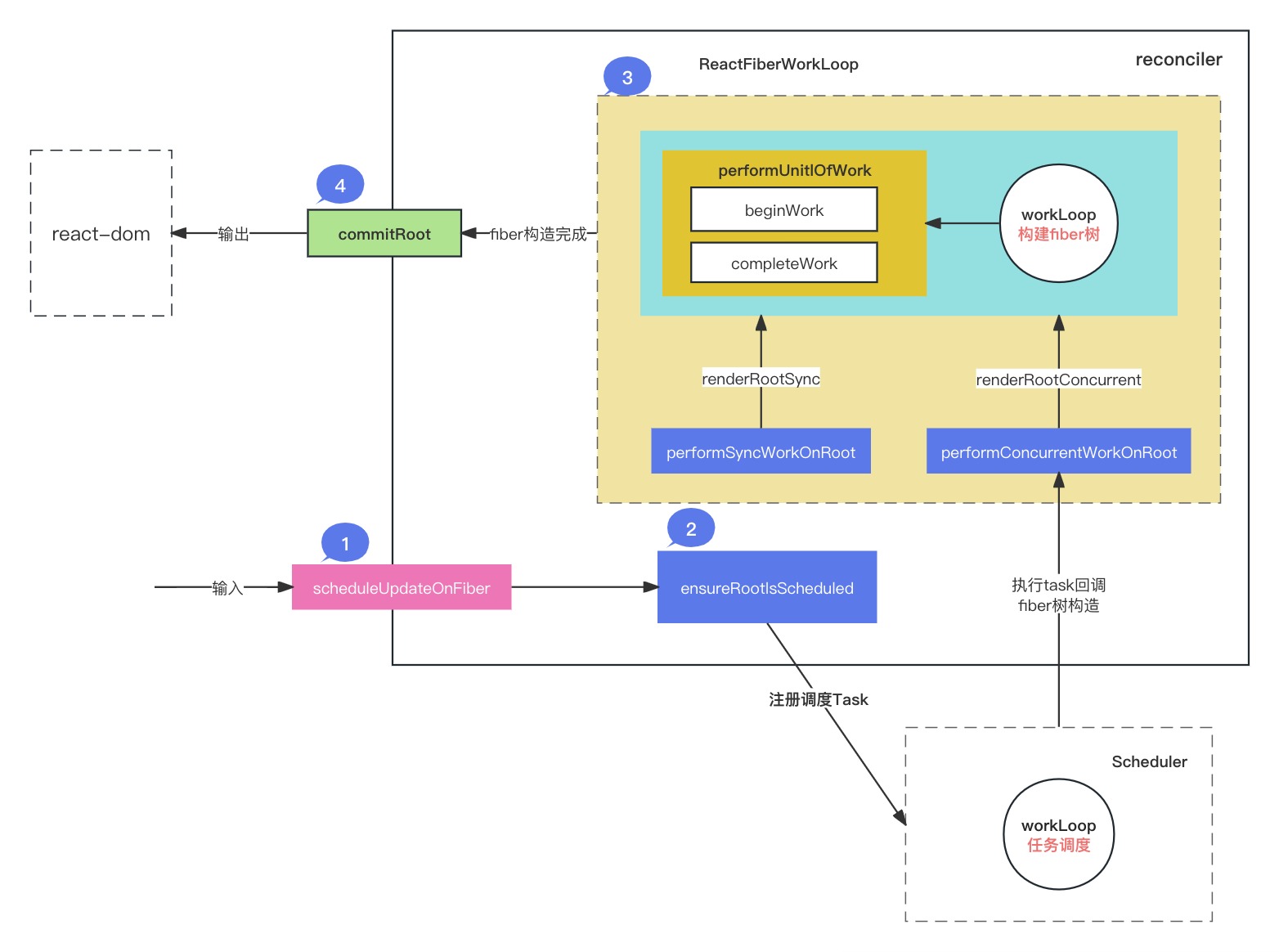reconciler执行流程
1 )概述
- 此处先归纳一下react-reconciler包的主要作用,将主要功能分为4个方面:
- 输入:暴露api函数(如:scheduleUpdateOnFiber), 供给其他包(如react包)调用
- 注册调度任务:与调度中心(scheduler包)交互,注册调度任务task,等待任务回调
- 执行任务回调:在内存中构造出fiber树,同时与渲染器(react-dom)交互,在内存中创建出与fiber对应的DOM节点
- 输出:与渲染器(react-dom)交互,渲染DOM节点

- 图中的1,2,3,4步骤可以反映react-reconciler包从输入到输出的运作流程
- 这是一个固定流程,每一次更新都会运行
2 )输入
-
在ReactFiberWorkLoop.js中,承接输入的函数只有scheduleUpdateOnFiber
-
在 react-reconciler 对外暴露的api函数中,只要涉及到需要改变fiber的操作(无论是首次渲染或后续更新操作)
-
最后都会间接调用 scheduleUpdateOnFiber
-
所以scheduleUpdateOnFiber函数是输入链路中的必经之路
//唯一接收输入信号的函数 export function scheduleUpdateOnFiber(fiber: Fiber,lane: Lane,eventTime: number, ) {// ... 省略部分无关代码const root = markUpdateLaneFromFiberToRoot(fiber, lane);// 同步if (lane === SyncLane) {if ((executionContext & LegacyUnbatchedContext) !== NoContext &&(executionContext & (RenderContext | CommitContext)) === NoContext) {// 直接进行fiber构造performSyncWorkOnRoot(root);} else {// 注册调度任务,经过`Scheduler'包的调度,间接进行`fiber构造'ensureRootIsScheduled(root, eventTime);}} else {// 注册调度任务,经过`Scheduler`包的调度,间接进行`fiber构造`ensureRootIsScheduled(root, eventTime);} } -
逻辑进入到scheduleUpdateOnFiber之后,后面有2种可能:
- 1.不经过调度,直接进行fiber构造.
- 2.注册调度任务,经过Scheduler包的调度,间接进行fiber构造.
2 )注册调度任务
与输入环节紧密相连,scheduleUpdateOnFiber函数之后,立即进入 ensureRootIsScheduled 函数
// ... 省略部分无关代码
function ensureRootIsScheduled(root: FiberRoot, currentTime: number) {//前半部分:判断是否需要注册新的调度const existingCallbackNode - root. callbackNode;const nextlanes = getNextLanes(root,root === workInProgressRoot ? workInProgressRootRenderLanes : NoLanes,);const newCallbackPriority = returnNextLanesPriority();if (nextLanes === NoLanes) {return;}if (existingCallbackNode !== null) {const existingCallbackPriority = root.callbackPriority;if (existingCallbackPriority === newCallbackPriority) {return;}cancelCallback(existingCallbackNode);}// 后半部分:注册调度任务let newCallbackNode;if (newCallbackPriority === SyncLanePriority){newCallbackNode = scheduleSyncCallback(performSyncWorkOnRoot.bind(null, root),);} else if (newCallbackPriority === SyncBatchedLanePriority) {newCallbackNode = scheduleCallback(ImmediateSchedulerPriority,performSyncWorkOnRoot.bind(null, root),);} else {const schedulerPriorityLevel = lanePriorityToSchedulerPriority(newCallbackPriority,);newCallbackNode = scheduleCallback(schedulerPriorityLevel,performConcurrentWorkOnRoot.bind(null, root),);}root.callbackPriority = newCallbackPriority;root.callbackNode = newCallbackNode;
}
- ensureRootIsScheduled的逻辑很清晰,分为2部分:
- 1.前半部分:判断是否需要注册新的调度(如果无需新的调度,会退出函数)
- 2.后半部分:注册调度任务
- performSyncWorkOnRoot 或 performConcurrentWorkOnRoot 被封装到了任务回调 (schedulecallback)
- 等待调度中心执行任务,任务运行其实就是执行 performSyncWorkOnRoot 或 performConcurrentWorkOnRoot
3 )执行任务回调
-
任务回调,实陈上就是执行 performSyncWorkOnRoot 或 performConcurrentWorkOnRoot
-
简单看一下它们的源码将主要逻辑剥离出来,单个函数的代码量并不多
//..,省略部分无关代码 function performSyncWorkOnRoot(root) {let lanes;let exitStatus;lanes = getNextLanes(root, NoLanes);// 1. fiber树构造exitStatus = renderRootSync(root, lanes);// 2. 异常处理:有可能fiber构造过程中出现异常if (root.tag !== LegacyRoot && exitStatus === RootErrored) {// ...}// 3. 输出:渲染fiber树const finishedWork: Fiber = (root.current.alternate: any);root.finishedwork = finishedWork;root.finishedLanes = lanes;commitRoot(root);// 退出前再次检测,是否还有其他更新,是否需要发起新调度ensureRootIsScheduled(root, now());return null; } -
performSyncWorkOnRoot 的逻辑很清晰,分为3部分:
-
fiber 树构造
-
异常处理: 有可能fiber构造过程中出现异常
-
调用输出
// ... 省略部分无关代码 function performConcurrentWorkOnRoot(root) {const originalCallbackNode = root.callbackNode;// 1、刷新pending状态的effects,有可能某些effect会取消本次任务const didFlushPassiveEffects = flushPassiveEffects();if (didFlushPassiveEffects) {if (root.callbackNode !== originalCallbackNode) {// 任务被取消,退出调用return null;} else {// Current task was not canceled. Continue.}}// 2.获取本次渲染的优先级let lanes = getNextLanes(root,root === workInProgressRoot ? workInProgressRootRenderLanes : NoLanes,);// 3.构造fiber树let exitStatus = renderRootConcurrent(root, lanes);if (includesSomeLane(workInProgressRootIncludedLanes,workInProgressRootUpdatedLanes,)) {// 如果在render过程中产生了新的update,且新update的优先级与最初render的优先级有交集// 那么最初render无效,丢弃最初render的结果,等待下一次调度prepareFreshStack(root, NoLanes);} else if (exitStatus !== RootIncomplete) {// 4、异常处理:有可能fiber构造过程中出现异常if (exitStatus == RootErrored) {// ...}const finishedWork: Fiber = (root.current. alternate: any);root.finishedWork = finishedwork;root.finishedLanes = lanes;// 5.输出:渲染fiber树finishConcurrentRender(root, exitStatus, lanes);}// 退出前再次检测,是否还有其他更新,是否需要发起新调度ensureRootIsScheduled(root, now());if (root.callbackNode === originalCallbackNode) {// 渲染被阻断,返回一个新的performConcurrentWorkOnRoot函数。等待下一次调用return performConcurrentWorkOnRoot.bind(null, root);}return null; }
-
-
performConcurrentWorkOnRoot 的逻辑与 performSyncWorkOnRoot 的不同之处在于
-
对于可中断渲染的支持:
- 1.调用 performConcurrentWorkOnRoot 函数时,首先检查是否处于 render 过程中,是否需要恢复上一次渲染
- 2.如果本次渲染被中断,最后返回一个新的 performConcurrentWorkOnRoot 函数,等待下一次调用
4 )输出
// ... 省略部分无关代码
function commitRootImpl(root, renderPriorityLevel) {// 设置局部变量const finishedWork = root.finishedWork;const lanes - root. finishedLanes;// 清空FiberRoot对象上的属性root.finishedWork = null;root.finishedLanes = NoLanes;root.callbackNode = null;// 提交阶段let firstEffect = finishedWork.firstEffect;if (firstEffect !== null) {const prevExecutionContext - executionContext;executionContext |= CommitContext;// 阶段1:dom突变之前nextEffect = firstEffect;do {commitBeforeMutationEffects();} while (nextEffect !== null);// 阶段2:dom突变,界面发生改变nextEffect = firstEffect;do {commitMutationEffects(root, renderPriorityLevel);} while (nextEffect !== null);root.current = finishedWork;// 阶段3:layout阶段,调用生命周期componentDidUpdate和回调函数等nextEffect = firstEffect;do{commitLayoutEffects(root, lanes);} while (nextEffect !== null);nextEffect = null;executionContext = prevExecutionContext;}ensureRootIsScheduled(root, now());return null;
}
- 在输出阶段,commitRoot 的实现逻辑是在 commitRootImpl 函数中
- 其主要逻辑是处理副作用队列,将最新的fiber树结构反映到DOM上
- 核心逻辑分为3个步骤:
- 1.commitBeforeMutationEffects
- dom变更之前,主要处理副作用队列中带有Snapshot, Passive标记的fiber节点
- 2.commitMutationEffects
- dom变更,界面得到更新.主要处理副作用队列中带有
- Placement,Update,Deletion, Hydrating标记的fiber节点
- 3.commitLayoutEffects
- dom变更后,主要处理副作用队列中带有 update | Callback 标记的fiber节点.
- 1.commitBeforeMutationEffects
- 这块流程参考 React16版本的流程,看下不同之处
- 参考: https://blog.csdn.net/Tyro_java/article/details/135845906
- 所以,整个 reconciler 的执行过程中,核心做了2个事情
- 1 )Render (基于task, 可以被打断, 可以被打断的前提是基于渲染 mode)
- 初始化 fiber
- 更新 fiber
- 2 )commit
- dom 变更之前
- dom 变更
- dom 更新之后
- 1 )Render (基于task, 可以被打断, 可以被打断的前提是基于渲染 mode)







)




)




)

风格的登录页,怎么就流行起来了呢?)